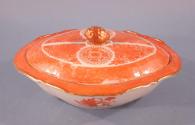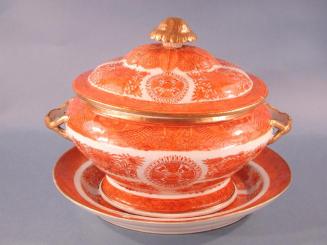Lidded Dishes
MakerMade by
Unknown
Date1800-1810
MediumMold-formed Chinese export porcelain with overglaze gilding and orange enamel
DimensionsPrimary Dimensions (height including lid x width x depth of .8a,b): 4 1/2 x 10 1/4 x 8 1/2in. (11.4 x 26 x 21.6cm)
Primary Dimensions (height including lid x width x depth of .9a,b): 4 1/2 x 10 1/4 x 8 3/8in. (11.4 x 26 x 21.3cm)
ClassificationsCeramics
Credit LineBequest of George Dudley Seymour
Object number1945.1.1396.8a,b-.9a,b
DescriptionPair of two oval, Chinese export porcelain lidded dishes with overglaze hand-painted orange enamel decoration in the Fitzhugh pattern. The Fitzhugh pattern consists of four groups of flowers and emblems, or geometric shapes, evenly spaced around a central circular medallion. This central medallion is a circular floral arrangement surrounded by a border consisting of a band of orange with darker lines creating a latticework, or diaper, pattern inside. At four points, this border is interrupted by an area of white with a small orange animal (possibly a dog). This is surrounded by a "Nanking" border, consisting of a series of lines that alternate between having an orange dot at either end or having an arrow pointing toward the central panel. Imperfections in the porcelain appear as black dots or lines in the surface of the ceramic.
Dishes (.a): Each oval dish has a flared rim with portions of the outer edge of the rim curving upward. The Fitzhugh pattern is hand-painted on the inside bottom surface of each dish and is surrounded by an elaborate border composed of geometric shapes, insects, and flowers on a field of orange enamel. A second border is hand-painted at the rim of each dish, consisting of crossed lines of orange enamel, creating a diamond or latticework pattern, on a field of orange. The outer edge of the rim is gilded, and four clusters of orange enamel flowers are hand-painted on the exterior sides of the dish.
Lids (.b): Each of the relatively flat, oval lids has an oval, organically shaped, gilded finial in the center. This is surrounded by a variation of the Fitzhugh pattern, where two panels of flowers surround a central medallion that appears on each side of the top of the lid. Finally, an elaborate border is hand-painted at the rim of each lid, composed of geometric shapes, insects, and flowers on a field of orange enamel.
The enamel has worn off, or been rubbed off during manufacture, one spot on the rim of the lid .8b. Several spots of an unknown green substance, possibly paint, have adhered to the exterior of dish .9a. One such spot is located on the lid. The enamel has worn off, or been rubbed off during manufacture, several spots along the rim of lid .9b.
Dishes (.a): Each oval dish has a flared rim with portions of the outer edge of the rim curving upward. The Fitzhugh pattern is hand-painted on the inside bottom surface of each dish and is surrounded by an elaborate border composed of geometric shapes, insects, and flowers on a field of orange enamel. A second border is hand-painted at the rim of each dish, consisting of crossed lines of orange enamel, creating a diamond or latticework pattern, on a field of orange. The outer edge of the rim is gilded, and four clusters of orange enamel flowers are hand-painted on the exterior sides of the dish.
Lids (.b): Each of the relatively flat, oval lids has an oval, organically shaped, gilded finial in the center. This is surrounded by a variation of the Fitzhugh pattern, where two panels of flowers surround a central medallion that appears on each side of the top of the lid. Finally, an elaborate border is hand-painted at the rim of each lid, composed of geometric shapes, insects, and flowers on a field of orange enamel.
The enamel has worn off, or been rubbed off during manufacture, one spot on the rim of the lid .8b. Several spots of an unknown green substance, possibly paint, have adhered to the exterior of dish .9a. One such spot is located on the lid. The enamel has worn off, or been rubbed off during manufacture, several spots along the rim of lid .9b.
Status
Not on view














